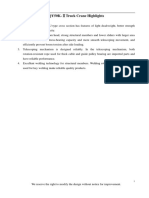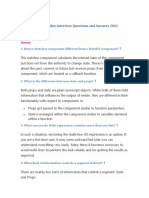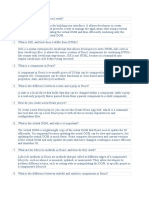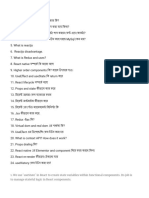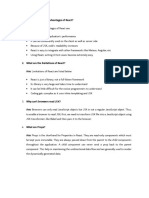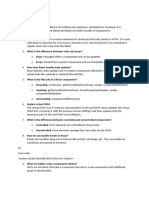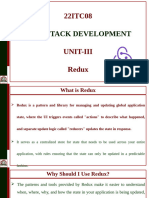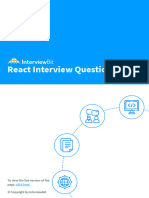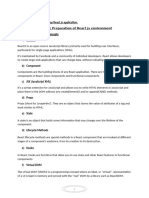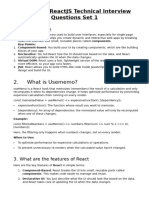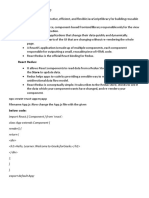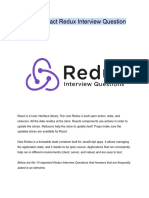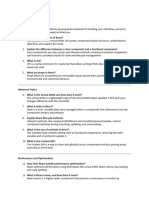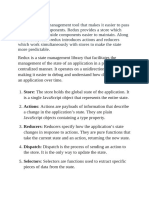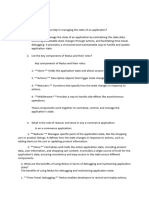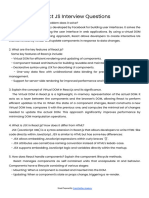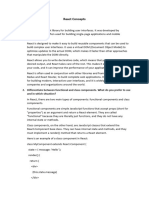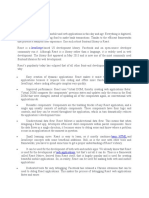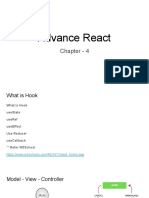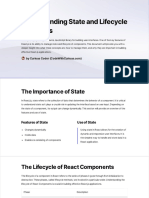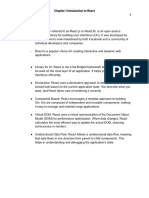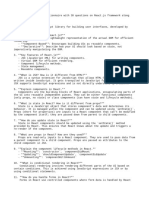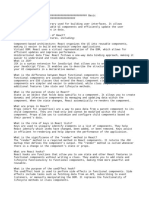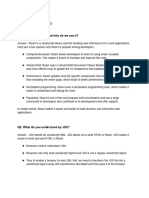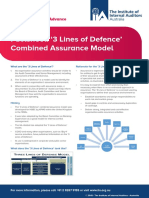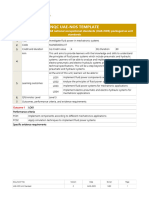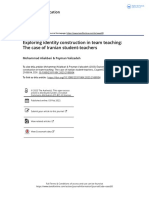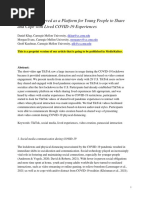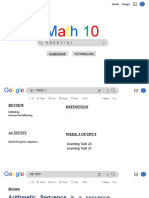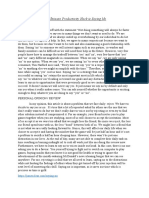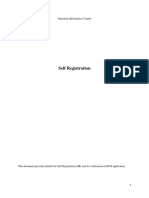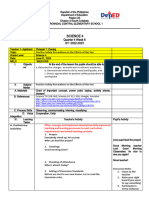What Is React
What Is React
Uploaded by
tamersaklyCopyright:
Available Formats
What Is React
What Is React
Uploaded by
tamersaklyOriginal Title
Copyright
Available Formats
Share this document
Did you find this document useful?
Is this content inappropriate?
Copyright:
Available Formats
What Is React
What Is React
Uploaded by
tamersaklyCopyright:
Available Formats
What is React?
List some of the major advantages of React.
How do you handle security in a React application?
What do you understand by Virtual DOM? Explain its works.
Differentiate between Real DOM and Virtual DOM.
What is a React hook?
Name some built-in hooks in React.
What is the difference between useState and useEffect?
What is Props?
What is a state in React and how is it used?
Differentiate between states and props.
Differentiate between stateful and stateless components.
Explain the lifecycle methods of React components in detail.
i. componentWillMount() – Executed just before rendering takes place both on the client as
well as server-side.
ii. componentDidMount() – Executed on the client side only after the first render.
iii. componentWillReceiveProps() – Invoked as soon as the props are received from the parent
class and before another render is called.
iv. shouldComponentUpdate() – Returns true or false value based on certain conditions. If you
want your component to update, return true else return false. By default, it returns false.
v. componentWillUpdate() – Called just before rendering takes place in the DOM.
vi. componentDidUpdate() – Called immediately after rendering takes place.
vii. componentWillUnmount() – Called after the component is unmounted from the DOM. It is
used to clear up the memory spaces.
What is Redux?
What are the three principles that Redux follows?
i. Single source of truth: The state of the entire application is stored in an object/ state tree
within a single store. The single state tree makes it easier to keep track of changes over time
and debug or inspect the application.
ii. State is read-only: The only way to change the state is to trigger an action. An action is a
plain JS object describing the change. Just like state is the minimal representation of data, the
action is the minimal representation of the change to that data.
iii. Changes are made with pure functions: In order to specify how the state tree is
transformed by actions, you need pure functions. Pure functions are those whose return value
depends solely on the values of their arguments.
List down the components of Redux.
Redux is composed of the following components:
i. Action – It’s an object that describes what happened.
ii. Reducer – It is a place to determine how the state will change.
iii. Store – State/ Object tree of the entire application is saved in the Store.
iv. View – Simply displays the data provided by the Store.
What are the advantages of Redux?
Advantages of Redux are listed below:
Predictability of outcome – Since there is always one source of truth, i.e. the store, there is
no confusion about how to sync the current state with actions and other parts of the
application.
Maintainability – The code becomes easier to maintain with a predictable outcome and strict
structure.
Server-side rendering – You just need to pass the store created on the server, to the client
side. This is very useful for initial render and provides a better user experience as it optimizes
the application performance.
Developer tools – From actions to state changes, developers can track everything going on
in the application in real time.
Community and ecosystem – Redux has a huge community behind it which makes it even
more captivating to use. A large community of talented individuals contribute to the betterment
of the library and develop various applications with it.
Ease of testing – Redux’s code is mostly functions which are small, pure and isolated. This
makes the code testable and independent.
Organization – Redux is precise about how code should be organized, this makes the code
more consistent and easier when a team works with it
What is the difference between a stateless component and a stateful component in React?
How do you handle performance optimization in a React application?
There are several ways to optimize the performance of a React application, including:
Using the shouldComponentUpdate lifecycle method to prevent unnecessary re-renders of
components.
Using React’s built-in PureComponent or implementing a custom shouldComponentUpdate
method to optimize performance for functional components.
Using the React developer tools to profile the application and identify performance
bottlenecks.
Using the React.memo method for functional components
Using React’s Context API instead of props drilling.
Using the useEffect hook to handle side effects in functional components.
Using the useCallback and useMemo hooks to prevent unnecessary re-renders and improve
performance.
Lazy loading of components and code splitting.
Minimizing the number of DOM updates by using the key prop when rendering a list of items.
Using the useReducer hook to manage state updates instead of useState
Using a virtualized list library like react-virtualized, react-window etc.
It’s always a good idea to test performance with real-world use cases and user interactions
before and after making any optimization.*
What is node js
Architecture of it
What is middleware in Node.js and how is it used?
What is RESTful API?
What is MongoDB?
How to Connect Node.js to a MongoDB Database?
How node ract mongodb works and communicate
You might also like
- ch06 Alt Redux PDFDocument42 pagesch06 Alt Redux PDFGustavo Luis Condoy PogoNo ratings yet
- Martha MC CaskeyDocument7 pagesMartha MC Caskeylakshya0% (1)
- Qy50k Ii 02Document10 pagesQy50k Ii 02Ali Fanani100% (1)
- ReactDocument11 pagesReactsourabh turekarNo ratings yet
- Top 100 React-Redux Interview Questions 2021Document34 pagesTop 100 React-Redux Interview Questions 2021israel juarez rodriguezNo ratings yet
- React QuestionsDocument252 pagesReact QuestionsCricket AustraliaNo ratings yet
- 100 Most Asked React - Js QnA PDFDocument10 pages100 Most Asked React - Js QnA PDFNarendra TavvaNo ratings yet
- React Q&ADocument6 pagesReact Q&A007Ãrnav SinghaNo ratings yet
- Q. ReactDocument4 pagesQ. ReactitalimbdNo ratings yet
- React Interview QuestionsDocument15 pagesReact Interview QuestionsDollyNo ratings yet
- Top 50 React Interview Questions and AnswerDocument9 pagesTop 50 React Interview Questions and Answeralt.b7-eo9ur6k2No ratings yet
- React Interview QuestionsDocument6 pagesReact Interview Questionstarun chowdaryNo ratings yet
- React Interview Questions With ExamplesDocument7 pagesReact Interview Questions With ExamplestestrahulkrNo ratings yet
- React JS 15 Interview QnsDocument4 pagesReact JS 15 Interview QnsAzizul HakimNo ratings yet
- React Interview QueDocument5 pagesReact Interview Quevinayakvyas7489No ratings yet
- 15 Interview Questions About REACTDocument4 pages15 Interview Questions About REACTtanzinatania491991No ratings yet
- Redux Interview Questions For FreshersDocument11 pagesRedux Interview Questions For Freshersskittou100% (1)
- React InvDocument45 pagesReact Invhy148964No ratings yet
- React JS QuestionsDocument13 pagesReact JS QuestionsMuthkkumar sivanandanNo ratings yet
- U3-02-React Redux and MUIDocument19 pagesU3-02-React Redux and MUIsowmyadell680No ratings yet
- React Js Interview QuestionDocument58 pagesReact Js Interview Questionmoradjay9No ratings yet
- PREPAREDNOTESDocument30 pagesPREPAREDNOTEShonorineniyokwizerwa741No ratings yet
- React Interview Question For MyselfDocument36 pagesReact Interview Question For Myselfsatya prakash singhNo ratings yet
- React interview questionsDocument6 pagesReact interview questionsujjwalkumar98355No ratings yet
- Important ReactJs Interview QuestionsDocument27 pagesImportant ReactJs Interview QuestionsNavneet KumarNo ratings yet
- ReactDocument7 pagesReactYash ShahNo ratings yet
- Must Do Top 10 React Redux Interview QuestionsDocument6 pagesMust Do Top 10 React Redux Interview QuestionsAnandNo ratings yet
- React_InterviewDocument5 pagesReact_InterviewimranNo ratings yet
- Top 100 React Interview Q&A ?Document9 pagesTop 100 React Interview Q&A ?andreea 1No ratings yet
- React 1Document12 pagesReact 1sheldon.claudius7No ratings yet
- 50 React Interview Questions You Must For Prepare in 2021Document30 pages50 React Interview Questions You Must For Prepare in 2021LUIS GOYBURONo ratings yet
- RTKDocument3 pagesRTKYash KadamNo ratings yet
- React Interview Questions? - Page-0001 (20 Files Merged)Document20 pagesReact Interview Questions? - Page-0001 (20 Files Merged)study materialNo ratings yet
- React ComponentDocument9 pagesReact ComponentL MeowNo ratings yet
- Mern Exp-15Document6 pagesMern Exp-15Preethi SriNo ratings yet
- ReactDocument28 pagesReactprithikareddydNo ratings yet
- HooksinreactsDocument9 pagesHooksinreactsMD Saif AliNo ratings yet
- MERN Interview Questions by ShilpiDocument21 pagesMERN Interview Questions by Shilpishilpigupta100194No ratings yet
- React 1Document36 pagesReact 1vivek kumarNo ratings yet
- React Concepts Q&ADocument9 pagesReact Concepts Q&AKapil SharmaNo ratings yet
- Redux FullDocument22 pagesRedux Fullchetanrathod1818No ratings yet
- React Q&ADocument1 pageReact Q&APratik SinghNo ratings yet
- Advanced React InterviewDocument15 pagesAdvanced React InterviewTuấn AnhNo ratings yet
- React Js Interview Questions 1700318879Document40 pagesReact Js Interview Questions 17003188796ggq6p474sNo ratings yet
- UNIT 6 React JSDocument17 pagesUNIT 6 React JSAdfar RashidNo ratings yet
- Advance ReactDocument23 pagesAdvance ReactAhmad Raza AnsariNo ratings yet
- Complete React JS Short NotesDocument95 pagesComplete React JS Short NotesRahul DoraNo ratings yet
- 1-Chapter-1 - IntroductionDocument7 pages1-Chapter-1 - Introductiongeeta sreeNo ratings yet
- REACT QnsDocument16 pagesREACT Qnsmehakpreet.sainiNo ratings yet
- React QuestionsDocument3 pagesReact QuestionsDurgeshNo ratings yet
- React Interview Questions 1704289355Document22 pagesReact Interview Questions 1704289355ainhoaboutique20No ratings yet
- Unit -V (React)Document83 pagesUnit -V (React)Jaya PrakashNo ratings yet
- Top 10 React Interview Questions 1664826029Document12 pagesTop 10 React Interview Questions 16648260295n6xsbt47zNo ratings yet
- Jiho Seok React Essentials - Building Modern Web Interfaces Independently Published - 2024Document137 pagesJiho Seok React Essentials - Building Modern Web Interfaces Independently Published - 2024mangaka crewNo ratings yet
- Ip QB (Unit 4)Document12 pagesIp QB (Unit 4)bhaydesanika07No ratings yet
- React IPDocument3 pagesReact IPVasita DevNo ratings yet
- Introduction To ReactDocument10 pagesIntroduction To ReactWaleed TanoliNo ratings yet
- Reactjs InterviewDocument32 pagesReactjs InterviewSagar ChaudhariNo ratings yet
- React NotesDocument16 pagesReact NotesManeesha SinghNo ratings yet
- React MainDocument74 pagesReact MainPrathapNo ratings yet
- React GuideDocument14 pagesReact Guidejbri1395No ratings yet
- Factsheet: 3 Lines of Defence' Combined Assurance Model: Connect Support AdvanceDocument2 pagesFactsheet: 3 Lines of Defence' Combined Assurance Model: Connect Support AdvanceWajdi AlissawiNo ratings yet
- Z211 Inst Tube FittingsDocument44 pagesZ211 Inst Tube FittingsSajeen100% (1)
- Huum Uku Paigaldus Ja Kasutusjuhend 2020Document100 pagesHuum Uku Paigaldus Ja Kasutusjuhend 2020Влад777 СмородинNo ratings yet
- Ashoka Studentkit 12-15-12 Final PDFDocument52 pagesAshoka Studentkit 12-15-12 Final PDFNicolas NiconectadoNo ratings yet
- Investigate Fluid Power in Mechatronic Systems NEWDocument6 pagesInvestigate Fluid Power in Mechatronic Systems NEWRazan Al AzzamNo ratings yet
- Bipolar Junction TransistorDocument15 pagesBipolar Junction TransistorpdekraaijNo ratings yet
- Exploring Identity Construction in Team Teaching The Case of IranianDocument16 pagesExploring Identity Construction in Team Teaching The Case of IranianNati MediaNo ratings yet
- ACL 3200 Flare Stack/Incinerator Ignition SystemDocument1 pageACL 3200 Flare Stack/Incinerator Ignition SystemRadu ScafariuNo ratings yet
- Curriculum Map Math 8Document20 pagesCurriculum Map Math 8Eliza Antolin CortadoNo ratings yet
- Klug, Evans, Kaufman - MedieKultur - TikTok COVIDDocument21 pagesKlug, Evans, Kaufman - MedieKultur - TikTok COVIDLeonie OngNo ratings yet
- 10 Welding Defect (LSNG PRINT)Document45 pages10 Welding Defect (LSNG PRINT)rahmad musliadiNo ratings yet
- Year 8 MathsDocument6 pagesYear 8 MathsNithyaNo ratings yet
- W E E K 3 - Q 1: Gmail ImagesDocument32 pagesW E E K 3 - Q 1: Gmail ImagesThe WeekndNo ratings yet
- Stamford Newage Alternator UCI274GDocument9 pagesStamford Newage Alternator UCI274Gedgar ricoNo ratings yet
- A.P.S. Certificate AcknowledgementDocument5 pagesA.P.S. Certificate AcknowledgementOm Prakash SinghNo ratings yet
- The Ultimate Productivity Hack Is Saying NoDocument1 pageThe Ultimate Productivity Hack Is Saying NoLiew JunNo ratings yet
- Training Matrix Oct 12 v3 For Health and Safety PDFDocument3 pagesTraining Matrix Oct 12 v3 For Health and Safety PDFSamsung JosephNo ratings yet
- Excellent Supply Chain ManagementDocument9 pagesExcellent Supply Chain Managementboomsta100% (2)
- User Manual of Self RegistrationDocument14 pagesUser Manual of Self RegistrationSanjayNo ratings yet
- List Price Book: January 2, 2013Document36 pagesList Price Book: January 2, 2013Juan Camilo Tejada OrjuelaNo ratings yet
- Yloiesah Southcot DemofinalDocument6 pagesYloiesah Southcot DemofinalYloiesah DaulogNo ratings yet
- ACTIVITY 1. Getting Out of The MazeDocument8 pagesACTIVITY 1. Getting Out of The MazeRicah PrestonNo ratings yet
- Verb To Be UladechDocument3 pagesVerb To Be UladechJhon ChinchayhuaraNo ratings yet
- PDCDocument3 pagesPDCal1starNo ratings yet
- HtkbookDocument354 pagesHtkbookYogesh AngalNo ratings yet
- Is QP 10 Indian AbacusDocument5 pagesIs QP 10 Indian AbacusIndian AbacusNo ratings yet
- Moonlighting - Typical Episode NotesDocument4 pagesMoonlighting - Typical Episode Notessanli hosanliNo ratings yet
- DRX-Evolution All Errors SummaryDocument241 pagesDRX-Evolution All Errors SummaryEvgenyNo ratings yet


